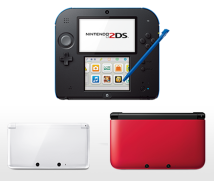5. Loads of Pre-installed Software
We decided early on to include an accelerometer24 in the Nintendo 3DS system. Then we decided quite a bit later to add the gyro sensor. 24Accelerometer: An electrical circuit element that can detect changes in speed. The accelerometer in the Wii Remote can detect the rate of acceleration in three dimensions.
About when was that?
I think it was February or March of 2010.
But earlier I had said, “The Nintendo 3DS specs are final!” (laughs)
I do remember you saying, “Nothing else will fit in.” (laughs)
That’s why I couldn’t guarantee that we would be in time for E3.
Konno-san also demonstrated a gyro sensor to me.
He hit you with another demo?! (laughs)
I thought the real thing would persuade him. (laughs) Our department just happened to be working on putting the Wii Remote and Wii MotionPlus25 together as a set. I put the equipment on a cart and wheeled it into the meeting room and asked, “So how about this?” 25Wii MotionPlus: An accessory with a gyro sensor for connection to the Wii Remote. The Wii Remote Plus, which features a built-in Wii MotionPlus, was released in October 2010 in Japan.
What kind of question is that?! (laughs)
(laughs)
The gyro sensor probably wouldn’t have come up if it weren’t for our experience with Wii MotionPlus.
I suppose not. I had heard Umezu-san say the specs were final, and I myself thought it might be difficult to achieve time-wise.
But a certain someone wouldn’t let it go.
Right. (laughs) Miyamoto-san.
When Miyamoto-san gets his heart set on something, he’ll say it’s all right to be late. I told him it wasn’t all right.
I told him, too. “We’ll fall behind!” (laughs)
I thought, “Maybe it’s impossible this time?” and held my peace, but Miyamoto-san and those guys wheeled in a cart with the equipment and said things like, “Isn’t it fun this way?” and “See what a big difference it makes?” (laughs)

The way that he insisted to put in the gyro sensor at that time was as forceful as when we put a speaker in the Wii Remote just prior to mass production of the Wii console and the boat was about to sail. So, I think it will come in handy somehow. I’m sure Miyamoto-san will do something later to prove it and say, “See? It was a good thing we put it in.”
(laughs)
We’re actually working on a number of ideas, like The Legend of Zelda: Ocarina of Time 3D26 and a submarine action game called Steel Diver.27 26The Legend of Zelda: Ocarina of Time 3D. An action-adventure game under development for Nintendo 3DS. It is based on The Legend of Zelda: Ocarina of Time, released for the Nintendo 64 system in 1998. 27Steel Diver: A submarine combat game featuring three modes: side-scrolling action, periscope action and strategy simulation. Under development for Nintendo 3DS and scheduled for release in the spring of 2011.
In Steel Diver, you sit in a swivel-chair and can survey every direction - a full 360 degrees.
You get dizzy if you do it too much, though! (laughs) Similarly, when you fire the slingshot in The Legend of Zelda: Ocarina of Time 3D, you can survey a full circle. And there’s a built-in game called Face Raiders.
Which already uses the gyro sensor.
So it’s a good thing we included it!
Aside from Face Raiders, the Nintendo 3DS has a lot of pre-installed software. You decided to put a lot of software into the system that wasn’t originally planned to be pre-installed. Why did you decide to put so much into the system itself?

Maybe we overextended ourselves? (laughs)
No, no! (laughs) Maybe it shows how much you love gadgets.
Maybe so. For example, I really wanted to put in software like AR Games.
AR stands for augmented reality, right?
Yes. For example, you place a card on the table and view it with the 3D camera, and then suddenly a monster appears! You can play games like that, where game characters move around on objects in the real world. When I first saw a sample of that, it made quite an impact.
We could have released AR Games as a separate, packaged game.
Yes, but we wanted it to be in the Nintendo 3DS system from the start, so everyone who bought a Nintendo 3DS could experience that kind of 3D play. That’s also why we included the Merge effect.
At the Nintendo Conference 201028, Miyamoto-san and I combined our faces. 28Nintendo Conference 2010: An exhibition for professionals in the gaming industry held at Makuhari Messe on September 29, 2010. The Nintendo 3DS system was first revealed in Japan at this event.
Yes. That also leaves a strong impact on you when you try it out for yourself.
Something interesting about the Merge effect is how some people have such strong features that no matter who they combine with, it ends up looking like them.
Yeah, people with overpowering features. (laughs)
Whoever that person combines with, it ends up looking like that person. I won’t say who, though. (laughs)
(laughs) And one I recommend is Mii Maker. You can use Mii characters in Mario Kart Wii, and I think making a caricature of yourself is fun, so I definitely wanted to enjoy them on a handheld system as well.
And we had already demonstrated the compatibility between Mii characters and handhelds with Tomodachi Collection.29 29Tomodachi Collection: A game where you have fun watching your Mii character communicating with Mii characters of your friends, family and others. It was released in Japan for Nintendo DS in June 2009.
Yes. This time, you can take a photo and it automatically creates a Mii.
It’s perfect for people who aren’t good at creating caricatures. But actually, there are times when it’s spot on and times when it’s off.
That’s right. But when it’s off a little, you just say, “Oh well,” and still enjoy it. The staff tends to debate what exact percent it should match, but for people like me who aren’t very artistic and don’t often make Mii characters, it’s extremely convenient to be able to make a Mii just by taking a photo, and if it doesn’t look exactly right, you can make as many adjustments as you want.
And it’s really pleasing when it looks just right. You’re also pouring a lot of energy into interaction between Mii characters this time.
Yes. There’s an interactive function for Mii characters in StreetPass, so we’re thinking about ways for Mii characters to interact a lot when you walk around with your Nintendo 3DS and pass someone.
You were involved in realising the first tag mode for the Nintendo DS system - the Bark Mode in Nintendogs.
That’s right. I wanted to do a lot more with tag mode for Nintendogs and following titles, but it wasn’t easy since you had to play in that mode for each game, so it didn’t really catch on.

You had to walk around with it in tag mode, so if there weren’t lots of other people playing the same game at the same time, nothing much happened. When the tag mode in Dragon Quest IX: Sentinels of the Starry Skies30 became a social phenomenon, were you jealous? 30Dragon Quest IX: Sentinels of the Starry Skies: An RPG released by Square Enix for the Nintendo DS system in July 2009 in Japan.
Extremely. (laughs) When I found that a number of game data were exchanged with tag modes just by walking around with it, I thought, “Aw, man!” I have a child, and even though he hardly ever wants to go shopping with me, he wanted to use the Dragon Quest IX: Sentinels of the Starry Skies tag mode, so...
He said, “Dad, I wanna go, too!” (laughs)
Yeah. He said, “I wanna go, I wanna go!” Especially when I went somewhere crowded.
(laughs)
You wanted him to do that with a game that you had made.
That’s right. For the Nintendo 3DS system, we made improvements so that if you’ve played a game just once, even if you don’t have the Game Card in the system, you can exchange data in StreetPass mode. And we thought it would be good if you didn’t have to go out at all - like if when you got up in the morning contents had come in automatically - so we put in SpotPass.31 Every time you open up your Nintendo 3DS, there will be something new to enjoy. 31SpotPass: A function that can connect to compatible public hotspots and through a wireless broadband Internet connection at home to automatically obtain various information and other content even when a Nintendo 3DS is in Sleep Mode.
